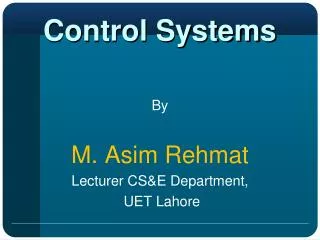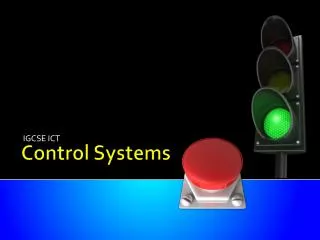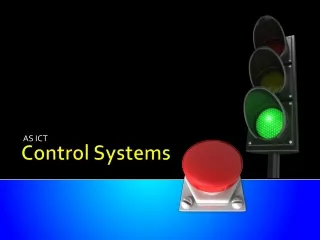Control Systems
Control Systems. Lect. 1 Introduction Basil Hamed. Introduction. 1. What is a control system. 2. Why control systems are important. 3. What are the basic components of a control system. 4. S ome examples of control-system applications.
Share Presentation
Embed Code
Link
Download Presentation
- problem formulation solution translation
- feedback control systems
- media speed
- recent years
- feedback system
- modeling physical systems

urit + Follow
Download Presentation
Control Systems
An Image/Link below is provided (as is) to download presentation Download Policy: Content on the Website is provided to you AS IS for your information and personal use and may not be sold / licensed / shared on other websites without getting consent from its author. Content is provided to you AS IS for your information and personal use only. Download presentation by click this link. While downloading, if for some reason you are not able to download a presentation, the publisher may have deleted the file from their server. During download, if you can't get a presentation, the file might be deleted by the publisher.
Presentation Transcript
- Control Systems Lect. 1 Introduction Basil Hamed
- Introduction 1. What is a control system. 2. Why control systems are important. 3.What are the basic components of a control system. 4. Some examples of control-system applications. 5.Why feedback is incorporated into most control systems. 6. Types of control systems. Basil Hamed
- What is a control system A control system is considered to be any system which exists for the purpose of regulating or controlling the flow of energy, information, money, or other quantities in some desired fashion. Basil Hamed
- What is a control system • An interconnection of components forming a system configuration that will provide a desired system response • The study of control provides us with a process for analyzing and understanding the behavior of a system given some input • It also introduces methods for achieving the desired system response Basil Hamed
- Input Output System Systems and Control A System is a device or process that takes a given input and produces some output: • A DC motor takes as input a voltage and produces as output rotary motion • A chemical plant takes in raw chemicals and produces a required chemical product
- Why control systems are important • In recent years, control systems have assumed an increasingly important role in the development and advancement of modern civilization and technology. • Practically every aspect of our day-to-day activities is affected by some type of control system. • Control systems are found in abundance in all sectors of industry, such as quality control of manufactured products, automatic assembly lines, machine-tool control, space technology and weapon systems, computer control, transportation systems, power systems, robotics, Micro-Electro-Mechanical Systems, nanotechnology, and many others. Basil Hamed
- Basic Components of a Control System 1. Objectives of control. 2. Control-system components. 3. Results or outputs. Basil Hamed
- Examples of Control-System Applications Potential applications of control of these systems may benefit the following areas: • Machine tools. Improve precision and increase productivity by controlling chatter. • Flexible robotics. Enable faster motion with greater accuracy. •Photolithography. Enable the manufacture of smaller microelectronic circuits by controlling vibration in the photolithography circuit-printing process. • Biomechanical and biomedical. Artificial muscles, drug delivery systems, and other assistive technologies. • Process control. For example, on/off shape control of solar reflectors or aerodynamic surfaces. Basil Hamed
- Examples of Control-System Applications Steering Control of an Automobile: • As a simple example of the control system, consider the steering control of an automobile. The direction of the two front wheels can be regarded as the controlled variable, or the output, y; the direction of the steering wheel is the actuating signal, or the input, u. • The control system, or process in this case, is composed of the steering mechanism and the dynamics of the entire automobile. However, if the objective is to control the speed of the automobile, then the amount of pressure exerted on the accelerator is the actuating signal, and the vehicle speed is the controlled variable. Basil Hamed
- Examples of Control Applications • Aerospace Applications: • Aircraft or missile guidance and control • Space vehicles and structures
- Examples of Control-System Applications Sun-Tracking Control of Solar Array: To achieve the goal of developing economically feasible non-fossil-fuel electrical power, development of solar power conversion methods, including the solar-cell conversion techniques Basil Hamed
- Why feedback is incorporated into most control systems Control Systems can be classified as : • open loop system (Nonfeedback System) • closed loop system (Feedback System). Basil Hamed
- Open-Loop Control Systems (Nonfeedback Systems) The elements of an open-loop control system can usually be divided into two parts: the controller and the controlled process, as shown by the block diagram Basil Hamed
- Open Loop Control Systems A system in which the output has no effect on the control action is known as an open loop control system. For a given input the system produces a certain output. If there are any disturbances, the out put changes and there is no adjustment of the input to bring back the output to the original value. Basil Hamed
- Open-Loop Control Systems • The controlled ‘output’ is the resulting toast • System does not reject changes in component characteristics Basil Hamed
- Closed-Loop Control Systems (Feedback Control Systems) • What is missing in the open-loop control system for more accurate and more adaptive control is a link or feedback from the output to the input of the system. • To obtain more accurate control, the controlled signal y should be fed back and compared with the reference input. Basil Hamed
- Process Dynamics Controller/ Amplifier Desired Output Input Output + - Measurement Open-Closed Loop Control Open-loop control is ‘blind’ to actual output Closed-loop control takes account of actual output and compares this to desired output
- TYPES OF FEEDBACK CONTROL SYSTEMS Feedback control systems may be classified in a number of ways, depending upon the purpose of the classification. For instance, according to the method of analysis and design, control systems are classified as: Linear or Nonlinear Time-varying or Time-invariant Continuous-data or Discrete-data Basil Hamed
- Control Many control systems can be characterised by these components Disturbance Plant Control Signal u(t) Output y(t) Reference r(t) Error e(t) Control Actuator Process + - Feedback Sensor Sensor Noise
- Actuation A device for acting on the environment
- Sensing A device for measuring some aspect of the environment
- Examples : Washing Machine • System Requirements • Understanding of load sizes • Receptacle to hold clothes • ‘Plumbing’ • Ease of use, Reliability • Low Cost • Actuators • AC or DC Motors • Water inlet/drain • Sensors • Water level • Load speed/balance • Control • Choice depends on design
- Examples : The CD Player • A CD player is an example of control system • Requires • Accurate positioning of the laser read head • Precise control of media speed • Conversion of digital data to analogue signal
- Examples : Hard Drive • A computer disk drive is another example of a rotary control system • Requires • Accurate positioning of the magnetic read head • Precise control of media speed • Extraction of digital data from magnetic media
- Examples : Modern Automobiles • Modern Automobiles are controlled by a number of computer components • Requires • Control of automobile sub systems • Brakes and acceleration • Cruise control • ABS • Climate control • GPS • Reliability • Low cost • Ease of use
- The Control Problem Generally a controller is required to filter the error signal in order that certain control criteria or specifications, be satisfied. These criteria may involve, but not be limited to: • Disturbance rejection • Steady state errors • Transient response characteristics • Sensitivity to parameter changes in the plant Basil Hamed
- The Control Problem Solving in control problem generally involves; • Choosing sensors to measure the plant output • Choosing actuators to drive the plant • Developing the plant, actuator, and sensors equations • Designing the controller • Evaluating the design analytically by simulation, and finally by testing the physical system. • If the physical tests are unsatisfactory, iterating these steps. Basil Hamed
- The Control Problem Problem Formulation Solution Translation • Mathematical model system Physical System • Mathematical solution of mathematical problem Basil Hamed
- Modeling Physical Systems - Overview Basil Hamed
- Modeling – Remarks • Modeling is the most important and difficult task in control system design. • No mathematical model exactly represents a physical system. Math Model ¹Physical System Math Model »Physical System • Do not confuse models with physical systems! • In this course, we may use the term “system” or “plant” to mean a mathematical model. Basil Hamed

Control Systems
Learning objectives. To understand different control strategies/configurations To design controllers using root locus technique To state the properties and structure of lead compensator To state the properties and structure of lag compensator To design controllers using frequency response tech
598 views • 30 slides

Control Systems
Learning objectives. To state the definition of PID controllersTo learn different forms of controller structuresTo learn different tuning techniques for PID controllersTo understand the effect of each controller parameter on the system responses.. PID controllers. PID stands for:P (Proportional
706 views • 25 slides

Control Systems
Control Systems. By M. Asim Rehmat Lecturer CS&E Department, UET Lahore. Introduction. Muhammad Asim Rehmat MS Computer Science in Artificial Intelligence, UET Lahore Belongs to SIALKOT and Engaged. Got 1 st prize in All Pak E-Club Project Exhibition
912 views • 38 slides

Control Systems
Control Systems. Lect.6 Stability Basil Hamed. Chapter 6. After completing this chapter the student will be able to : Make and interpret a basic Routh table to determine the stability of a system (Sections 6.1-6.2 )
1.4k views • 42 slides

CONTROL SYSTEMS
CONTROL SYSTEMS. Control Systems. General Nature of the Control Problem Set of performance standards Standards establish control parameters A description (model) of physical system Analyze performance of system model Modify system to improve performance. Types of Control Systems.
366 views • 11 slides

Control Systems
IGCSE ICT. Control Systems. Objectives. True control system is when the computer is controlling the output dependent on information from sensors about what is happening. Be able to describe a number of uses, giving the hardware and software requirements.
732 views • 23 slides

Control Systems
Control Systems. The elements of a control system Open and closed loop system differences Positive and negative feedback Examples of systems with feedback. Classic closed loop control. Elements of a control system . Another Example.
631 views • 14 slides

Control Systems
Control Systems. Example control systems. Automatic doors Heating systems T axi meters Elevators Washing machines Domestic robots (e.g. Roomba) GPS systems, Traffic lights Process control (automation in factories). Typical control system (feedback loop).
564 views • 7 slides

Control Systems
Control Systems. Lect.5 Reduction of Multiple Subsystems Basil Hamed. Chapter Learning Outcomes. After completing this chapter the student will be able to: • Reduce a block diagram of multiple subsystems to a single block representing the transfer function (Sections 5.1-5.2)
1.31k views • 53 slides

Control Systems
Control Systems. Lect.2 Modeling in The Frequency Domain Basil Hamed. Chapter Learning Outcomes. • Find the Laplace transform of time functions and the inverse Laplace transform (Sections 2.1-2.2) • Find the transfer function from a differential equation and solve
1.6k views • 70 slides

Control Systems
Control Systems. Lect.8 Root Locus Techniques Basil Hamed. Chapter Learning Outcomes. After completing this chapter the student will be able to:. Root Locus – What is it?. W . R. Evans developed in 1948.
996 views • 32 slides

Control Systems
Control Systems. Lect.3 Modeling in The Time Domain Basil Hamed. Chapter Learning Outcomes. After completing this chapter, the student will be able to: • Find a mathematical model, called a state-space representation, for a linear, time invariant system (Sections 3.1-3.3)
1.1k views • 64 slides

Control Systems
Control Systems. Lect.7 Steady State Error Basil Hamed. Chapter Learning Outcomes. After completing this chapter the student will be able to: Find the for a unity feedback system (Sections 7.1-7.2) Specify a system's performance (Section 7.3)
1.19k views • 44 slides

Control Systems
Control Systems. Mathematical Modeling. By Dr. Juma Yousuf Alaydi. Mathematical Modeling of Dynamic Systems. Modeling of Mechanical System. Thank You.
498 views • 17 slides

Control Systems
Control Systems. Computer Control Systems make devices and machines do what we want them to do in the right order and at the right time. Objectives:. Control Systems. Write down the cycle of lights in the left-hand column of your table. Control Systems. Watch the video and check your table.
316 views • 7 slides

Control Systems
Control Systems. Lect.4 Time Response Basil Hamed. Roadmap (Time Responses). Chapter Learning Outcomes. After completing this chapter the student will be able to : • Use poles and zeros of transfer functions to determine the time response of a control system (Sections 4.1-4.2)
878 views • 64 slides

Control Systems
Control Systems. Complex, Dynamic Interactions. Control System as Model. Any control system involves an internal model of the world, from the simple heating thermostat to the admiral’s control of a battle fleet.
240 views • 7 slides

Control Systems
Control Systems. Lect.8 Root Locus Techniques Basil Hamed. Chapter Learning Outcomes. After completing this chapter the student will be able to : Define a root locus (Sections 8.1-8.2) State the properties of a root locus (Section 8.3) Sketch a root locus (Section 8.4)
887 views • 49 slides

CONTROL SYSTEMS
CONTROL SYSTEMS. B.Tech – II – ECE – II SEMESTER. M.MYSIAH Assistant Professor ACE ENGINEERING COLLEGE. 5. UNIT - II. Time. R esponse. An a l y sis. UNIT – II: Time R esponse Anal y sis. . Time Do m ain A n al y sis. . T r ansi e n t and S t eady S t at e R esponse
2.3k views • 211 slides

Control Systems
Control Systems. Chapter 1 Introduction to Control System. 1.1 Introduction Automatic control played a vital role in the advance of engineering and science. - Space-vehicle systems - Missile guidance systems - Robotics systems. Definition:
253 views • 13 slides

Control Systems
Control Systems. Lecture 1: Introduction. Dr. Mohammed Gulam Ahamad. Text Books. Control Systems Engineering, (6 th Edition) By: Norman S. Nise . Modern Control Systems, (12 th Edition) By: Richard C. Dorf and Robert H. Bishop.
3.26k views • 55 slides

Control Systems
AS ICT. Control Systems. Objectives. Have an understanding of how organizations use ICT. Be able to describe a number of uses, giving the hardware and software requirements. Be able to describe the applications that these uses can be put to. What is a control system?.
329 views • 18 slides
























